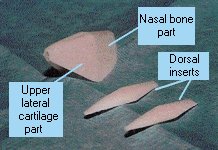Implants
Various implant materials are used to augment
the size of the nose. This is particularly so for Asian patients
who seem to tolerate the implants better than Caucasian
patients.
Silicone has been a popular material for
nasal implants over many years. The implants are specially shaped
to fit over the skeletal bridge and they resemble a saddle in
shape and function. There may or may not be an additional piece
for the columella in which case the overall shape is an "L". The
advantage of silicone is ease of insertion and ease of removal
should problems arise.
Silicone implants have not worked well for Caucasian
patients. Too many implants become infected and extrude.
Plastic surgeons in Japan report almost none of these problems
and some of those surgeons implant hundreds of implants every
year. This racial difference is probably due to Caucasians often
having a history of trauma, accidental or surgical, when they
need nose augmentation.
Some newer implant materials are now in use.
Many of these are porous and allow for tissue ingrowth (eg.
Medpor). This may have the advantage of better
retention for Caucasian patients. It is possible to remove the implant if it is necessary for
any reason.
| Paul O'Keeffe designed the Medpor Nasal Shell and results since February
1999 were very encouraging. The Australian agents are Medical Vision Australia and Precise Medical Supplies.
It went on sale in the United States in October 1999. The implant
is a very thin shell that fits over the existing
skeleton (bone and upper lateral cartilages). |
 |
| The outer surface is shaped to resemble the surface
of the skeleton as would be found within a normal nose.
It is smooth with a very fine pore size to facilitate insertion
(and adjustment or removal, if that ever became necessary). The
under surface has larger pores for tissue ingrowth. Separate
Medpor inserts are available for fitting beneath the dorsum of
the shell if voids exist. The shell supports the lower portion of
the nose thereby improving the airway. |
 |
| The Nasal Shell can be trimmed to a smaller
size and inserted into the nasal dorsum via a nostril.
When used near full size it is often necessary
to perform a semi-open operation, lifting the
skin from the columella and dividing the columella cartilages
anteriorly. The width of both nostrils is then available through
which to place the implant. |
 |
| By March 2001 Paul O'Keeffe had inserted 36 Nasal Shells. 35
patients were Caucasian and all had previous nasal trauma.
Results were excellent and infection followed by rejection is not
a major problem. One implant has been removed for infection. That
compares with an infection-rejection rate of 60% when silicone
implants were used by him in the 1970s.
Improvements in manufacture have allowed Porex Surgical to make a much
thinner version of the Nasal Shell. It is used
as a shaping device for crushed cartilage that
is placed beneath it. There is less implant material so the
infection rate should be further reduced and the shell could be
removed once the cartilage graft has solidified. |
Click here for
RESULTS
|
| By August 2008 Paul O'Keeffe had inserted 60 of the new
Thin Nasal Shells. The preferred technique now
involves attaching a piece of cartilage to the end of the shell
and placement of fragmented cartilage beneath the shell.
These new shells are more flexible than the original shells
and can be placed via a nostril, thereby avoiding the columella
incision.
|
 |
Back to Top
|




